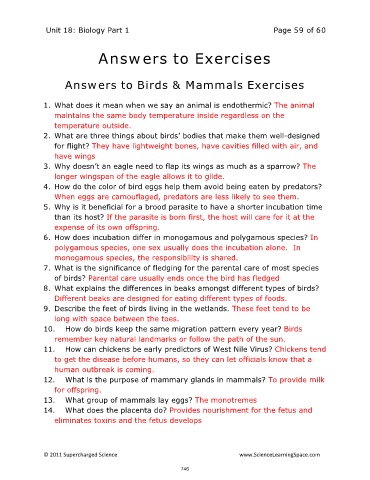Page 344 - Microsoft Word - LessonPlan-Overview.doc
P. 344
Unit 18: Biology Part 1 Page 59 of 60
Answers to Exercises
Answers to Birds & Mammals Exercises
1. What does it mean when we say an animal is endothermic? The animal
maintains the same body temperature inside regardless on the
temperature outside.
2. What are three things about birds’ bodies that make them well-designed
for flight? They have lightweight bones, have cavities filled with air, and
have wings
3. Why doesn’t an eagle need to flap its wings as much as a sparrow? The
longer wingspan of the eagle allows it to glide.
4. How do the color of bird eggs help them avoid being eaten by predators?
When eggs are camouflaged, predators are less likely to see them.
5. Why is it beneficial for a brood parasite to have a shorter incubation time
than its host? If the parasite is born first, the host will care for it at the
expense of its own offspring.
6. How does incubation differ in monogamous and polygamous species? In
polygamous species, one sex usually does the incubation alone. In
monogamous species, the responsibility is shared.
7. What is the significance of fledging for the parental care of most species
of birds? Parental care usually ends once the bird has fledged
8. What explains the differences in beaks amongst different types of birds?
Different beaks are designed for eating different types of foods.
9. Describe the feet of birds living in the wetlands. These feet tend to be
long with space between the toes.
10. How do birds keep the same migration pattern every year? Birds
remember key natural landmarks or follow the path of the sun.
11. How can chickens be early predictors of West Nile Virus? Chickens tend
to get the disease before humans, so they can let officials know that a
human outbreak is coming.
12. What is the purpose of mammary glands in mammals? To provide milk
for offspring.
13. What group of mammals lay eggs? The monotremes
14. What does the placenta do? Provides nourishment for the fetus and
eliminates toxins and the fetus develops
© 2011 Supercharged Science www.ScienceLearningSpace.com
746

